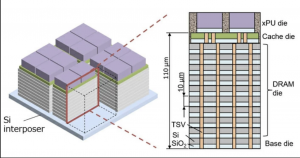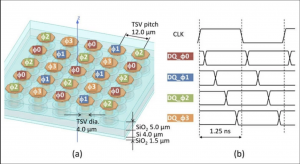BBCube 3D, a technology for three-dimensional integration of processing units and memory, has achieved the highest attainable performance in the world.
Paving the way to faster and more efficient computing, BBCube 3D achieves higher data transmission bandwidths than other state-of-the-art memory technologies. Moreover, it minimises the energy needed for bit access.
The most important breakthrough made with this technology is that it has the potential to resolve issues associated with the integration of PUs and dynamic random access memory (DRAM).
What are some of the issues associated with data transmission?
In the digital age, engineers and researchers have developed new computer-assisted technologies that require higher data bandwidths between the processing units and memory chips.
Examples of modern bandwidth-extensive applications include Artificial Intelligence, molecular simulations, climate prediction, and genetic analysis.
Until BBCube 3D, data transmission has proved difficult. To increase the data bandwidth, either more wires must be added between the PUs and the memory or the data rate needs to be increased.
The first approach is too difficult to implement because transmission between the components usually happens in two dimensions, making the addition of more wires tricky.
On the other hand, increasing the data rate requires increasing the energy needed to access a bit each time (the bit access energy), which is also difficult.
This is where BBCube 3D comes into play.
How BBCube 3D makes the connection between units
The most notable aspect of the new technology is its ability to realise connections between PUs and DRAMs in three dimensions instead of two (Fig. 1).

The team was able to achieve this using an innovative stacked structure in which the PU sits on multiple layers of DRAM, which are all connected via through-silicon vias (TSVs).
The compact architectures of BBCube 3D, along with its lack of solder microbumps and the use of TSVs in place of wires, contribute to low parasitic capacitance and low resistance. This drastically improves the electrical performance of the device.
The device is more advanced than other state-of-the-art technologies
The researchers implemented an innovative strategy that involved four-phase shielded inouts/outputs (IOs) to make BBCube 3D more resistant to noise.
They adjusted the timing of adjacent IO lines so that they were always out of phase with each other, meaning they could never change value at the same time (Fig. 2). This reduces crosstalk noise and makes the operation of BBCube 3D more robust.

The team evaluated the speed of these lines and compared it to two other leading memory technologies, DDR5 and HBM2E.
“The BBCube 3D has the potential to achieve a bandwidth of 1.6 terabytes per second, which is 30 times higher than DDR5 and four times higher than HBM2E,” explained Professor Takayuki Ohba, who led the research.
Additionally, the technology also represents a major breakthrough when it comes to bit access energy. Professor Ohba said: “Due to the low thermal resistance and low impedance of BBCube 3D, the thermal management and power supply issues typical of 3D integration can be relieved.”
He concluded: “As a result, the proposed technology could reach a remarkable bandwidth with a bit access energy that is 1/20th and 1/5th of DDR5 and HBM2E, respectively.”
Overall, BBCube 3D has the potential to pave the way for faster and more efficient computing and aid progression in numerous fields.









